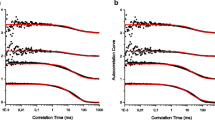Abstract
Fluorescence correlation spectroscopy (FCS) is a powerful technique to study the lateral organization of membranes. It measures fluorescence intensity fluctuations in the single molecule regime and allows the determination of diffusion coefficients. When applied to lipid membranes, their fluidity and lipid phase can be estimated from the diffusion rates of fluorescent particles partitioned to the membrane. Here, we describe the theoretical basis of FCS and discuss the z-scan approach for measurements on lipid membranes. We also list the materials necessary for a FCS experiment on giant unilamellar vesicles (GUVs). Finally, we present simple protocols for the preparation of GUVs and the acquisition and analysis of FCS data on the vesicles, so that diffusion coefficients of fluorescent probes within lipid membranes can be estimated.
Access this chapter
Tax calculation will be finalised at checkout
Purchases are for personal use only
Similar content being viewed by others
References
Singer SJ, Nicolson GL (1972) The fluid mosaic model of the structure of cell membranes. Science 175:720-731
Simons K, Ikonen E (1997) Functional rafts in cell membranes. Nature 387:569-572
Simons K, Vaz WLC (2004) Model systems, lipid rafts, and cell membranes. Annu Rev Biophys Biomol Struct 33:269-295
Garcia-Saez AJ, Schwille P (2007) Single molecule techniques for the study of membrane proteins. Appl Microb Biotechnol 76:257-266
Eigen M, Rigler R (1994) Sorting single molecules - application to diagnostics and evolutionary biotechnology. Proc Natl Acad Sci U S A 91:5740-5747
Magde D, Webb WW, Elson E (1972) Thermodynamic fluctuations in a reacting system - measurement by fluorescence correlation spectroscopy. Phys Rev Lett 29:705
Chiantia S, Ries J, Kahya N, Schwille P (2006) Combined AFM and two-focus SFCS study of raft-exhibiting model membranes. Chem-physchem 7:2409-2418
Cordeaux Y, Briddon SJ, Alexander SP, Kellam B, Hill SJ (2008) Agonist-occupied A3 adenosine receptors exist within heterogeneous complexes in membrane microdomains of individual living cells. FASEB J 22(3):850-60
Doeven MK, van den Boggart G, Krasnikov VV, Poolman B (2008) Probing receptor-translocator interactions in the oligopeptide ABC transporter by fluorescence correlation spectroscopy. Biophys J 94(10):3956-3965
Kahya N, Scherfeld D, Bacia K, Poolman B, Schwille P (2003) Probing lipid mobility of raft-exhibiting model membranes by fluorescence correlation spectroscopy. J Biol Chem 278:28109-28115
Smithers NP, Hodgkinson CP, Cuttle M, Sale GJ (2008) Insulin-triggered repositioning of munc18c on syntaxin-4 in GLUT4 signalling. Biochem J 410:255-260
Swift JL, Burger MC, Massotte D, Dahms TE, Cramb DT (2007) Two-photon excitation fluorescence cross-correlation assay for ligand-receptor binding: cell membrane nanopatches containing the human micro-opioid receptor. Anal Chem 79:6783-6791
Bacia K, Schwille P, Kurzchalia T (2005) Sterol structure determines the separation of phases and the curvature of the liquid-ordered phase in model membranes. Proc Natl Acad Sci U S A 102:3272-3277
Kahya N, Scherfeld D, Bacia K, Schwille P (2004) Lipid domain formation and dynamics in giant unilamellar vesicles explored by fluorescence correlation spectroscopy. J Struct Biol 147:77-89
Lenne PF, Wawrezinieck L, Conchonaud F, Wurtz O, Boned A, Guo XJ, Rigneault H, He HT, Marguet D (2006) Dynamic molecular confinement in the plasma membrane by microdomains and the cytoskeleton meshwork. EMBO J 25:3245-3256
Ries J, Schwille P (2008) New concepts for fluorescence correlation spectroscopy on membranes. Phys Chem Chem Phys 10(24):3487-3497
Petrov EP, Schwille P (2008) State of the art and novel trends in fluorescence correlation spectroscopy. Springer Ser. Fluoresc. 6:145-197
Ries J, Schwille P (2006) Studying slow membrane dynamics with continuous wave scanning fluorescence correlation spectroscopy. Biophys J 91:1915-1924
Benda A, Benes M, Marecek V, Lhotsky A, Hermens WT, Hof M (2003) How to determine diffusion coefficients in planar phospholipid systems by confocal fluorescence correlation spectroscopy. Langmuir 19:4120-4126
Humpolickova J, Gielen E, Benda A, Fagulova V, Vercammen J, Vandeven M, Hof M, Ameloot M, Engelborghs Y (2006) Probing diffusion laws within cellular membranes by Z-scan fluorescence correlation spectroscopy. Biophys J 91:L23-L25
Ries J, Schwille P (2006) Studying slow membrane dynamics with continuous wave scanning fluorescence correlation spectroscopy. Biophys J 91:1915-1924
Chiantia S, Kahya N, Schwille P (2007) Raft domain reorganization driven by short- and long-chain ceramide: a combined AFM and FCS study. Langmuir 23:7659-7665
Petrasek Z, Schwille P (2008) Precise measurement of diffusion coefficients using scanning fluorescence correlation spectroscopy. Biophys J 94:1437-1448
Culbertson CT, Jacobson SC, Michael Ramsey J (2002) Diffusion coefficient measurements in microfluidic devices. Talanta 56:365-373
Dertinger T, Pacheco V, von der Hocht I, Hartmann R, Gregor I, Enderlein J (2007) Two-focus fluorescence correlation spectroscopy: a new tool for accurate and absolute diffusion measurements. Chemphyschem 8:433-443
Author information
Authors and Affiliations
Corresponding author
Editor information
Editors and Affiliations
Rights and permissions
Copyright information
© 2010 Humana Press, a part of Springer Science+Business Media, LLC
About this protocol
Cite this protocol
García-Sáez, A.J., Carrer, D.C., Schwille, P. (2010). Fluorescence Correlation Spectroscopy for the Study of Membrane Dynamics and Organization in Giant Unilamellar Vesicles. In: Weissig, V. (eds) Liposomes. Methods in Molecular Biology™, vol 606. Humana Press. https://doi.org/10.1007/978-1-60761-447-0_33
Download citation
DOI: https://doi.org/10.1007/978-1-60761-447-0_33
Published:
Publisher Name: Humana Press
Print ISBN: 978-1-60761-446-3
Online ISBN: 978-1-60761-447-0
eBook Packages: Springer Protocols




